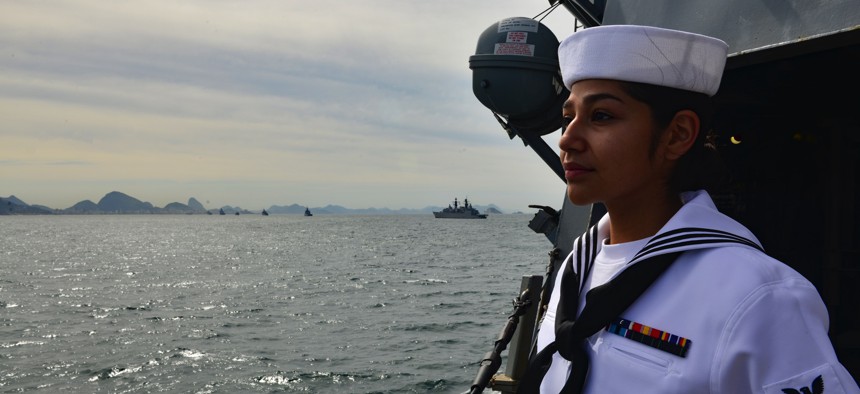
A 4th Fleet petty officer mans the rails aboard the Arleigh Burke-class guided-missile destroyer USS Lassen (DDG 82) off Brazil during Unitas 2022. U.S. Navy / Mass Communication Specialist 1st Class Mitch Meppelink
Navy Expands Unmanned Operations to 4th Fleet
U.S. Southern Command’s naval component will follow 5th Fleet into heavy-duty experimentation with drones.
NATIONAL HARBOR, Maryland—Drones are heading to the southern waters of 4th Fleet, which will follow 5th Fleet’s pioneering experiments with unmanned craft in the Middle East, Navy Secretary Carlos Del Toro announced Tuesday at the Navy League’s 2023 Sea-Air-Space Conference.
“The 4th Fleet area of operations provides us with an environment best suited to operationalize the concepts of Task Force 59, that has worked tirelessly to develop to increase our maritime domain awareness or MDA capabilities,” Del Toro said.
Instead of hiving off its drones into a task force, 4th Fleet will integrate them into its command and staff structure, Chief of Naval Operations Adm. Mike Gilday told reporters.
“Intelligence, operations, plans, manpower—so it'll all be integrated in. So we wanted to take a different approach rather than a task force this time, because as I mentioned, we're integrating additional sensors into the battlespace, and we think this is another way to normalize them,” Gilday said.
Task Force 59’s drones have been used to monitor 5th Fleet waters, when they helped “more effectively prosecute Iranian vessels, for example, conducting illegal arms trade to terrorist organizations,” Del Toro said.
In 4th Fleet, drones will help combat human trafficking, drug smuggling, and illegal fishing, the secretary said.
“The goal here is to have far better [intelligence, surveillance, and reconnaissance] across the entire area of operations so that we can actually deter the flow of drugs into the United States, as well as help our allies and partners in their ever challenging situation that they have with regards to illegal fishing,” he told reporters.
How many drones will operate in 4th Fleet—which operates around Central and South America and in the Caribbean—is still unknown. Gilday said the number will “be informed by the progress that we see, by getting an understanding of the battlespace we want to cover, and what makes most sense with respect to numbers. We’re just not at that point yet. So we'll be doing some learning. And the good thing about this capability is we can scale it fast.”
Del Toro added, “it’s fair to say however, you want to start small and build upon it, obviously. And so you know, focus perhaps on the Caribbean Basin first, and then expand beyond that in the future.”
For now, the drones will be aircraft and surface vessels, Gilday said. He said the exact types were still under discussion.
Del Toro said it will be based on lessons from 5th Fleet’s Task Force 59.
Gilday did say that some of the drones under consideration were on the exhibit floor at Sea-Air-Space. That could include one of the unmanned craft made by Saildrone. Iranian forces tried twice to steal one last year.
Fourth Fleet will kick off its drone operations at the annual UNITAS exercise in July Gilday said.
Task Force 59 reached full operational capacity in January and has spent the last few years experimenting and exercising with commercial drones to see how unmanned vessels can be used by the Navy alongside its manned ships. This summer, 5th Fleet is expected to fill out its planned fleet of 100 unmanned surface vessels, including craft contributed by foreign militaries.





